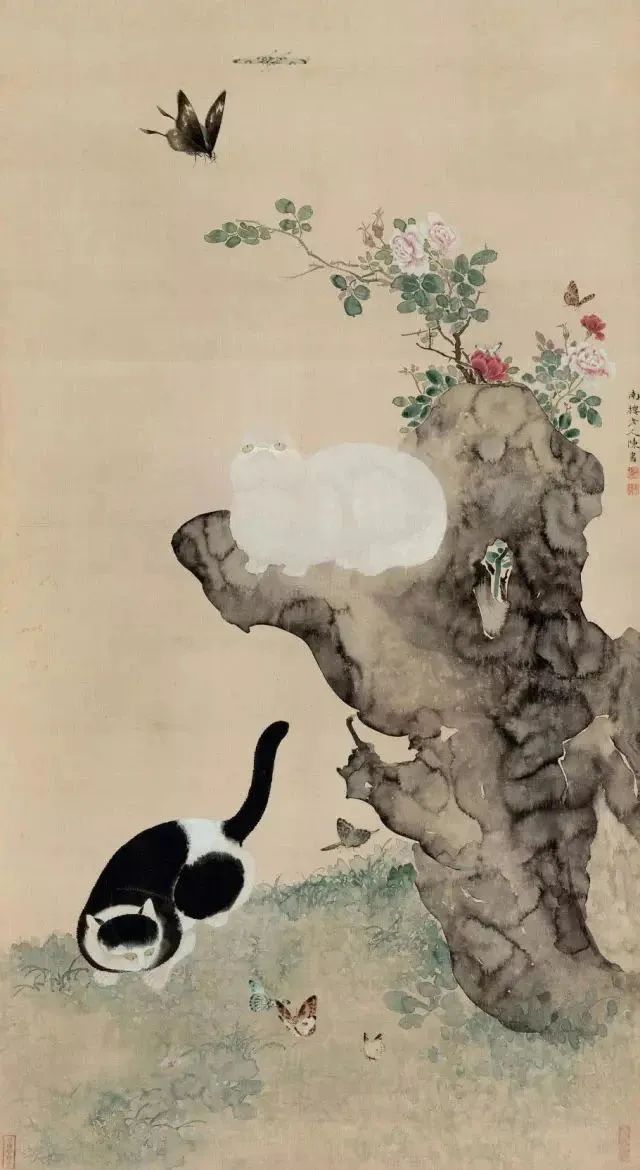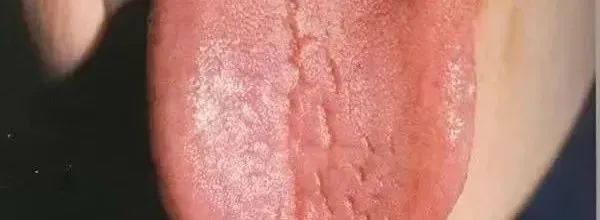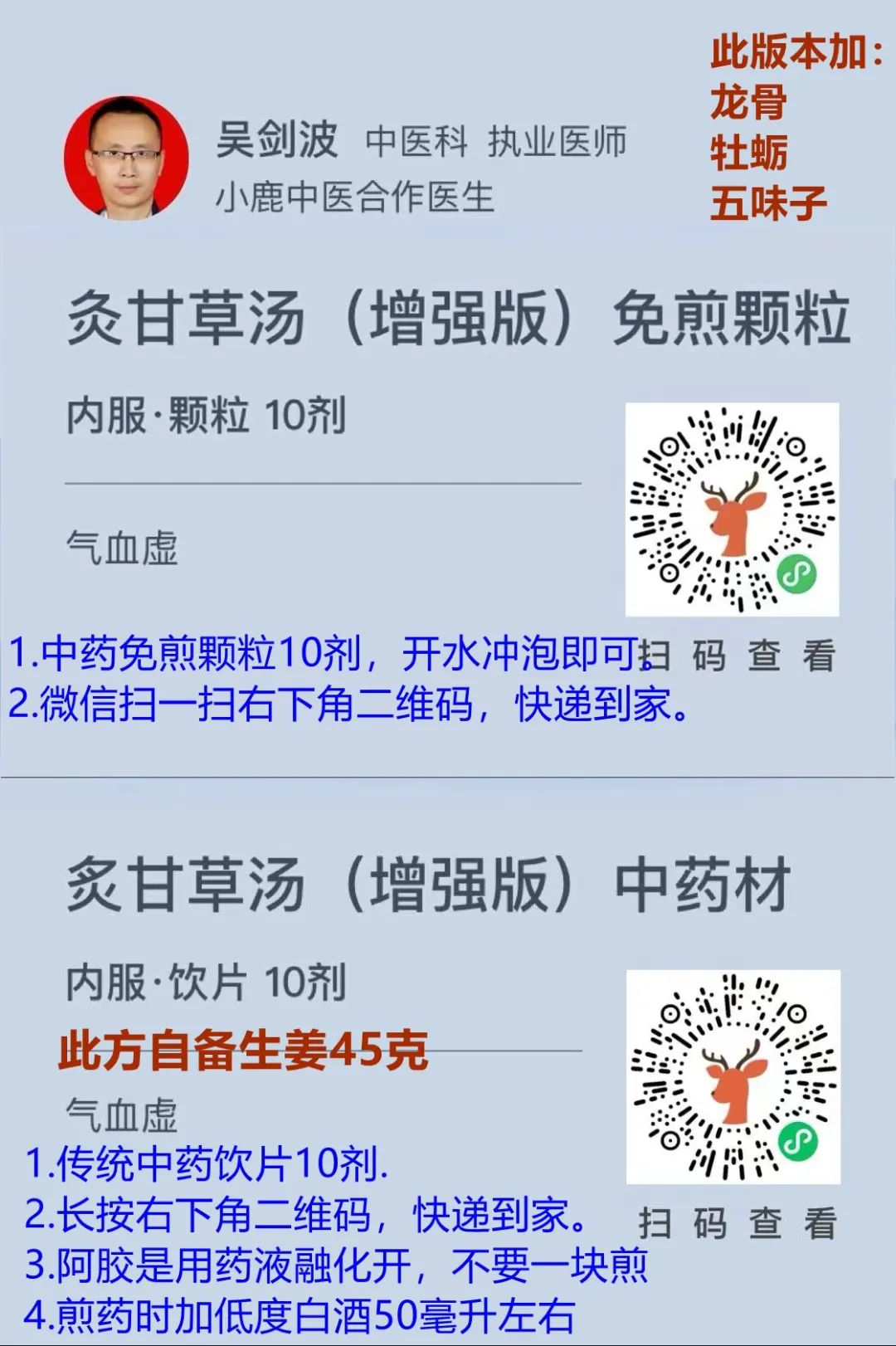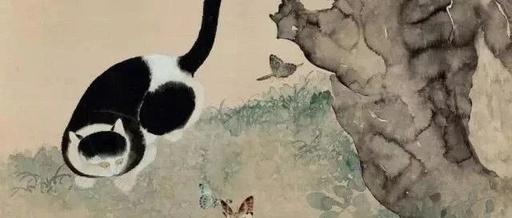

Indeed, after writing about some well-known formulas from textbooks, the readership has significantly increased.“The Grandma of Blood Nourishment – Si Wu Tang (Four Substance Decoction)”“The Shrew of Blood Nourishment – Dang Gui Bu Xue Tang (Angelica Blood Nourishing Decoction)”These blood nourishing formulas are merely second-rate skills for our loyal fans.They resemble the Black Tiger Gang, the Giant Whale Gang, and the Divine Dragon Sect in the martial arts world.Today, I will discuss the last blood nourishing formula from the textbook, Zhi Gan Cao Tang (Honey-Fried Licorice Decoction). Originating from the authentic Shaolin and the renowned Wudang school, it is recorded in the “Shang Han Lun (Treatise on Cold Damage).” Only this formula deserves my special attention.In short, Zhi Gan Cao Tang is a formula for treating heart blood deficiency. How can I say that?What is its medicinal composition and theoretical basis that justifies calling it the ancestor of blood nourishment?The Ancestor of Blood Nourishment – Zhi Gan Cao Tang#2013.11.1701In the article “The Grandma of Blood Nourishment – Si Wu Tang,” we introduced the ancient methods of blood nourishment in Traditional Chinese Medicine (TCM).The “Huang Di Nei Jing (Yellow Emperor’s Classic of Internal Medicine)” states: “The spleen and stomach are the middle burner, receiving qi and extracting fluids, nourishing the heart to produce blood”.Zhi Gan Cao Tang perfectly embodies this theory.To nourish yin, one must first nourish yang; yang can generate yin and blood.
Zhi Gan Cao Tang (also known as Fu Mai Tang)
From the “Shang Han Lun”
[Composition] 4 liang (12g) of Zhi Gan Cao (Honey-Fried Licorice), 3 liang (9g) of Sheng Jiang (Fresh Ginger), 2 liang (6g) of Ren Shen (Ginseng), 1 jin (30g) of Sheng Di Huang (Raw Rehmannia), 3 liang (9g) of Gui Zhi (Cinnamon Twig), 2 liang (6g) of Pi Gao (Prepared Gelatin), 0.5 sheng (15g) of Mai Men Dong (Ophiopogon), 0.5 sheng (10g) of Ma Zi Ren (Hemp Seed), and 30 Da Zao (Jujube) (5-10 pieces), cut.
[Usage] Combine the nine ingredients with 7 sheng of clear wine and 8 sheng of water, first boil the eight ingredients, take 3 sheng and discard the residue, dissolve the gelatin completely, and take 1 sheng warm, three times a day (modern usage: leave out the gelatin, mix the other herbs, decoct, pour out the juice, and add 10ml of clear wine. Then, slightly dissolve the gelatin in hot water, divide into three doses, mix with the herbal juice, and consume. One dose decocted three times, to be finished in one day).
[Function] Tonifies qi, nourishes yin, replenishes blood, and restores pulse.
[Indications] (1) Qi deficiency and blood weakness. Pulse shows knotted or intermittent, palpitations, weakness, shortness of breath, pale tongue, and little moisture. (2) Deficiency consumption and lung atrophy. Dry cough without phlegm, or phlegm with little blood, thin body, shortness of breath, restlessness, poor sleep, spontaneous sweating or night sweats, dry throat, dry tongue, difficult bowel movements, or fever during deficiency heat, pulse is weak and rapid.
[Formula Explanation] This formula is used in the “Shang Han Lun” for treating symptoms of “knotted and intermittent pulse, palpitations.” The clinical manifestations of knotted and intermittent pulse are as described in the “Bin Hu Mai Xue (Pulse Studies)”: “Knotted pulse is slow and regular, sometimes stopping and then returning”; “Intermittent pulse is rapid and stops in between, unable to return on its own, and then moves again.” This condition is caused by yang deficiency failing to circulate the pulse qi, and yin deficiency failing to nourish the heart blood. Restlessness and insomnia, along with a pale tongue and little moisture, are also due to insufficient yin blood. Deficiency consumption, dry cough, blood-streaked phlegm, spontaneous sweating, night sweats, dry throat, and dry tongue are all manifestations of insufficient yin fluids, leading to internal dryness harming the lung collaterals, or yin deficiency generating heat, causing internal steaming and forcing sweat to leak out. Therefore, the formula uses Zhi Gan Cao, Ren Shen, and Da Zao to tonify qi and nourish the heart and spleen; Sheng Di Huang, Mai Men Dong, Pi Gao, and Ma Zi Ren to moisten and nourish yin, nourish the heart and replenish blood, and moisten the lungs and generate fluids; while Sheng Jiang, Gui Zhi, and wine are all warm in nature, having the function of warming yang and restoring pulse, and when paired with qi tonifying and yin nourishing herbs, they can warm without drying, and also promote the circulation of qi and blood, ensuring the pulse pathways are unobstructed. Together, they achieve the effects of tonifying qi, restoring pulse, nourishing yin, and replenishing blood.
This is the textbook explanation, which may be confusing; no need to read it, just follow Teacher Wu’s rhythm.Why is this formula called Zhi Gan Cao Tang? Isn’t Gan Cao (Licorice) a harmonizer? Doesn’t it harmonize all the herbs?When used at 1 liang, Gan Cao serves to moderate the properties of the herbs. However, when used at 4 liang, it becomes a yang tonifying herb.“Why is Licorice called the ‘Harmonizer’?”Public account: TCM Practitioner Wu Jianbo, Article 87From the name of this formula, you can tell that it is a major tonifying formula.Let’s elaborate:First Group of Herbs: Yang Tonifying HerbsZhi Gan Cao, Sheng Jiang, Gui Zhi, Ren Shen, and wine.Are you familiar with the first three? Half of Gui Zhi Tang (Cinnamon Twig Decoction) is meant to allow energy to surge from the heart to the body’s surface, inducing sweating to release the exterior. It removes the herb Shao Yao (Peony), which causes blood to be constrained in the liver, and purely becomes a structure for tonifying heart yang. Adding Ren Shen enhances the strength of heart yang tonification.When decocting, use 7 sheng of clear wine and 8 sheng of water. This wine is also a medicinal herb, promoting blood circulation and unblocking collaterals.“When I drink wine, it feels fragrant; I must be getting old.”Public account: TCM Practitioner Wu Jianbo, Article 56Second Group of Herbs: Yin Nourishing HerbsSheng Di Huang, Pi Gao, Mai Men Dong, and Ma Zi Ren.Sheng Di Huang is a plant herb, while Pi Gao is an animal product.This combination serves as the raw materials for blood production.“The Number One Blood Nourishing Herb – This Herb Sheng Di Huang”“This Herb Pi Gao – Anyone Using It to Nourish Blood is a Fool”Mai Men Dong is a major herb for nourishing the stomach and the qi of the interior, specifically at the apex of the heart’s pulsation.Ma Zi Ren is a moistening herb that nourishes the five internal organs. It ensures that blood flows to the five internal organs. We know there is a formula for treating elderly constipation called Ma Zi Ren Wan (Hemp Seed Pill), which moistens the large intestine.“Ma Zi Ren Wan – A Must-Have for Home, A Formula for Treating Constipation”Using yang to control yin can generate blood.02Let’s see how Shang Han Lun uses it. In Shang Han Lun:Zhi Gan Cao Tang appears twice.Once in the “Deficiency Consumption Chapter” and once in the “Cough Chapter”.First, let’s discuss the “Deficiency Consumption Chapter”:
[8.53] In cases of cold damage, if the pulse is knotted and rapid, and there are palpitations, Zhi Gan Cao Tang is the main treatment.
Zhi Gan Cao Tang Formula
4 liang of Zhi Gan Cao (Honey-Fried Licorice), 3 liang of Sheng Jiang (Fresh Ginger, sliced), 2 liang of Ren Shen (Ginseng), 0.5 jin (15g) of Sheng Di Huang (Raw Rehmannia), 3 liang of Gui Zhi (Cinnamon Twig), 0.5 sheng (15g) of Mai Men Dong (Ophiopogon), 2 liang of Pi Gao (Prepared Gelatin), 0.5 sheng (10g) of Ma Zi Ren (Hemp Seed), and 12 Da Zao (Jujube) (sliced).
Combine the nine ingredients with 7 sheng of clear wine, first boil the eight ingredients, take 3 sheng, discard the residue, dissolve the gelatin completely, and take 1 sheng warm, three times a day.
It has two diagnostic points:Knotted and Rapid Pulse:The pulse is irregular.Knotted pulse is a pulse that beats slowly and regularly, but suddenly stops for a moment. It feels like it has tied a knot. The pulse beats slowly, and then suddenly misses a beat. This indicates that the body’s yang qi is deficient, causing it to slow down and miss a beat.Rapid pulse is a pulse that beats quickly and regularly, but suddenly stops for a moment. The pulse beats quickly, and then suddenly misses a beat. This indicates that the yang is excessive, which is a sign of yin deficiency; the yang qi is strong, but the blood is insufficient, causing it to miss a beat.The commonality is that the pulse stops unexpectedly for a moment. What does this indicate? The blood in the vessels is insufficient.Palpitations:Irregular heartbeats, feeling anxious, and the heart pounding can be felt. This also indicates insufficient blood, which causes the heart to pump faster to circulate blood.Both indicators point to: insufficient blood, blood deficiency.Additionally, a thin tongue coating or cracks in the middle, dry eyes, and other symptoms of yin deficiency. Or, if measured with a blood pressure monitor, low blood pressure. Use this Zhi Gan Cao Tang. In the beginning, the words: “Cold Damage” subtly hint at something:This irregular heartbeat is caused by external wind-cold evil qi. For example, rheumatic heart disease.After the COVID-19 pandemic, many people have developed symptoms of anxiety, palpitations, and irregular heartbeats. Have you experienced this?03Is every irregular heartbeat treated with Zhi Gan Cao Tang? Not necessarily; you must confirm that it is due to blood deficiency before using it.Irregular heartbeats in Western medicine are called arrhythmias, palpitations, and irregular heartbeats.Zhi Gan Cao Tang addresses heart disease caused by blood deficiency.We previously learned about Gua Lou Xie Bai Ban Xia Tang (Trichosanthes, Allium, and Pinellia Decoction).“What to Do When the Heart is Covered by Turbid Phlegm? – Gua Lou Xie Bai Ban Xia Tang”Public account: TCM Practitioner Wu Jianbo, Article 45This condition is due to phlegm obstructing the heart.If the complexion is pale, with teeth marks on the tongue, and a fear of cold, this indicates water toxicity; this type of heart yang deficiency causing irregular heartbeat can be treated with Si Ni Tang (Frigid Extremities Decoction) or Zhen Wu Tang (True Warrior Decoction) combined with Sheng Mai San (Generate Pulse Powder).If the two veins under the tongue are thick and purple, and there are tender points in the abdomen, this indicates blood stasis causing irregular heartbeat, which can be treated with Wang Qingren’s Xue Fu Zhu Yu Tang (Blood Mansion Dispersing Stasis Decoction) combined with Sheng Mai San.04In the “Shang Han Lun”, Zhi Gan Cao Tang appears twice.The second time is in the “Cough Chapter”:
In the beginning, the words: “Cold Damage” subtly hint at something:This irregular heartbeat is caused by external wind-cold evil qi. For example, rheumatic heart disease.After the COVID-19 pandemic, many people have developed symptoms of anxiety, palpitations, and irregular heartbeats. Have you experienced this?03Is every irregular heartbeat treated with Zhi Gan Cao Tang? Not necessarily; you must confirm that it is due to blood deficiency before using it.Irregular heartbeats in Western medicine are called arrhythmias, palpitations, and irregular heartbeats.Zhi Gan Cao Tang addresses heart disease caused by blood deficiency.We previously learned about Gua Lou Xie Bai Ban Xia Tang (Trichosanthes, Allium, and Pinellia Decoction).“What to Do When the Heart is Covered by Turbid Phlegm? – Gua Lou Xie Bai Ban Xia Tang”Public account: TCM Practitioner Wu Jianbo, Article 45This condition is due to phlegm obstructing the heart.If the complexion is pale, with teeth marks on the tongue, and a fear of cold, this indicates water toxicity; this type of heart yang deficiency causing irregular heartbeat can be treated with Si Ni Tang (Frigid Extremities Decoction) or Zhen Wu Tang (True Warrior Decoction) combined with Sheng Mai San (Generate Pulse Powder).If the two veins under the tongue are thick and purple, and there are tender points in the abdomen, this indicates blood stasis causing irregular heartbeat, which can be treated with Wang Qingren’s Xue Fu Zhu Yu Tang (Blood Mansion Dispersing Stasis Decoction) combined with Sheng Mai San.04In the “Shang Han Lun”, Zhi Gan Cao Tang appears twice.The second time is in the “Cough Chapter”:
[14.25] If there is persistent coughing with copious phlegm, dry throat, and thirst, and the pulse is floating, thin, and rapid, this indicates lung atrophy, and Zhi Gan Cao Tang is the main treatment.
Zhi Gan Cao Tang Formula
4 liang of Zhi Gan Cao (Honey-Fried Licorice), 3 liang of Gui Zhi (Cinnamon Twig), 0.5 sheng (15g) of Mai Men Dong (Ophiopogon), 0.5 sheng (10g) of Ma Zi Ren (Hemp Seed), 0.5 jin (15g) of Sheng Di Huang (Raw Rehmannia), 2 liang of Pi Gao (Prepared Gelatin), 2 liang of Ren Shen (Ginseng), 3 liang of Sheng Jiang (Fresh Ginger), and 30 Da Zao (Jujube).
Combine the nine ingredients with 7 sheng of clear wine and 8 sheng of water, first boil the eight ingredients, take 3 sheng, discard the residue, dissolve the gelatin completely, and take 1 sheng warm, three times a day.
Persistent Cough with Copious PhlegmThis person has been coughing continuously, producing a lot of phlegm.Dry Throat and ThirstHowever, the throat is very dry.This indicates lung atrophy, where the lung tissue has become fibrotic, and the fluids are flowing chaotically.Floating, Thin, and Rapid PulseThis is a basic pulse pattern indicating yin deficiency with heat.In TCM, this is called lung atrophy, similar to Western medicine’s chronic obstructive pulmonary disease (COPD).The dosage of the formula has changed.The amount of Sheng Di Huang has increased from 0.5 jin to 1 jin (250g). The number of Da Zao has increased from 12 to 30.Only by using such a large dosage of blood nourishing agents can we saturate the extremely deficient lung tissue and save it.05What other diseases can it treat?Actually, it addresses various symptoms of yin and blood deficiency.
Physical emaciation, dry mouth and throat, flushed cheeks, five hearts feeling hot, short yellow urine, dry and hard stools, pale or yellow complexion, dizziness, palpitations, forgetfulness.
For women, scanty menstrual flow and pale color, or even amenorrhea.This type of condition.
In Western medical terms, this includes low blood pressure and anemia.This is undoubtedly called the ancestor of blood nourishment; who else is stronger than it?Various heart diseases, such as viral myocarditis, rheumatic heart disease, arrhythmias, and premature beats.I am not a clinical Western medicine professional, so I may not write about these accurately.However, this formula is particularly effective for conditions triggered by cold viruses.Recently, after the COVID-19 pandemic, many people have developed lingering symptoms.Palpitations, anxiety. After walking a short distance, the heart pounds. This is the perfect time to use it.It can also be used for hyperthyroidism, with symptoms of irritability, restlessness, insomnia, palpitations, fatigue, and weight loss.It can also be used for chronic gastritis, particularly atrophic gastritis, where insufficient yin blood leads to fibrosis of the gastric mucosa.In summary, this formula is effective for various diseases related to yin deficiency and blood deficiency, even for elderly constipation and dry eyes.06What is the difference from Si Wu Tang?Teacher Wu, you boast so much; what is the difference between this and the previous Si Wu Tang for blood nourishment?Si Wu Tang is a formula for regulating blood.It can ensure that menstruation comes on time; this is its focus.If you want to use it for blood nourishment, you must take 12g of cooked Sheng Di Huang for a long time until the body accumulates enough Sheng Di Huang for the bone marrow to start producing blood. The effect of blood nourishment is slow.In contrast, Zhi Gan Cao Tang immediately uses 120g of Sheng Di Huang, allowing you to produce blood by tomorrow. For those with money, this is how generous it is.07Women rely on blood.Due to their unique physiological structure, pregnancy, childbirth, and menstruation can lead to significant blood loss compared to men.This blood is crucial for women.Insufficient blood can lead to blood toxicity, which means the waste in the blood cannot be expelled, easily accumulating, leading to poor complexion and various gynecological diseases.Some women love beauty, trying various treatments like light therapy, Botox injections, and facelifts.In my opinion, it is better to regulate the body.With abundant qi and blood, the complexion will be rosy.Long-term consumption of Zhi Gan Cao Tang can also be combined with Da Huang Chuan Chong Wan (Rhizoma Rhei and Chuan Chong Pill), which helps to clear the stasis in the capillaries of the skin, wouldn’t that be better?Some herbal formulas may have biases when consumed long-term.However, this formula is precisely one that can be consumed long-term.08How to take Zhi Gan Cao Tang:
Combine the nine ingredients with 7 sheng of clear wine and 8 sheng of water, first boil the eight ingredients, take 3 sheng, discard the residue, dissolve the gelatin completely, and take 1 sheng warm, three times a day.
Many people often complain that taking TCM has no effect.The textbook dosage of Zhi Gan Cao is 12g. In the “Shang Han Lun,” the dosage of Zhi Gan Cao is 4 liang, which is now 60g. The tonifying properties of Zhi Gan Cao change to harmonizing properties, altering the medicinal properties.In the “Deficiency Consumption Chapter,” the blood nourishing agent Sheng Di Huang is used at half a jin (120g) to achieve both blood nourishment and blood circulation effects. Sufficient blood volume is necessary to clear the stasis in the blood vessels.Consider the Yellow River; if the water volume is low, it cannot carry away the silt, leading to a suspended river in Henan. Before liberation, flooding was common in Henan.In the “Cough Chapter,” to treat lung atrophy, Sheng Di Huang is used at 1 jin (240g). Such a large dosage is necessary to saturate the fibrotic lung tissue and alveoli.Can a mere 30g of Sheng Di Huang achieve this effect? Not discussing dosage is just playing tricks.The original text states: Combine with 7 sheng of clear wine and 8 sheng of water, first boil the eight ingredients.In this formula, wine is also a medicinal herb. Using warm, blood-circulating, and hot wine can counteract the cold nature of Sheng Di Huang. Did you use wine when decocting this soup?Some people replace Sheng Di Huang with Shu Di Huang (Prepared Rehmannia). Using Shu Di Huang gives a feeling of blockage.You hear it is Zhi Gan Cao Tang, you buy Zhi Gan Cao Tang, but who knows what you are drinking? Will it be effective? Instead, it leads to the belief that TCM is ineffective.09Teacher Wu has thoughtfully (and financially) created an:
Enhanced Version of Zhi Gan Cao Tang.
 1. Long press the bottom right corner of the image to purchase. 2. 10 doses of medicine, delivered by SF Express to your home.3. “Methods, Drinking Methods, and Precautions for Decocting Chinese Medicine.” (Click to view) 4. When boiling the medicine, add 45g of Sheng Jiang. 5. Pi Gao should be added to the medicinal liquid after boiling, do not boil it together, as it will stick to the pot.6. The alcohol content of the clear wine should be around 15 degrees. When boiling the medicine with clear wine (search online for what clear wine is), use half water and half clear wine. If using low-alcohol white wine as a substitute, use one-third low-alcohol white wine and two-thirds water.Is that enough? Not enough.I added Wu Wei Zi (Schisandra) to Zhi Gan Cao Tang.This is Ren Shen, Mai Men Dong, Wu Wei Zi, Sheng Mai Yin (Generate Pulse Decoction).I also added Long Gu (Dragon Bone) and Mu Li (Oyster Shell) to help the body’s energy enter the blood.“A Formula for Spontaneous Sweating – Long Gu and Mu Li”This formula is quite expensive, mainly due to the high price of Pi Gao, costing nearly 200 yuan per dose, primarily used for blood nourishment. As for treating lung atrophy with Zhi Gan Cao Tang, the dosage is even larger, so I won’t be selling this formula; you can gather the herbs yourself.Alright, the series on blood tonifying and nourishing formulas from the “Shang Han Lun” is complete.
1. Long press the bottom right corner of the image to purchase. 2. 10 doses of medicine, delivered by SF Express to your home.3. “Methods, Drinking Methods, and Precautions for Decocting Chinese Medicine.” (Click to view) 4. When boiling the medicine, add 45g of Sheng Jiang. 5. Pi Gao should be added to the medicinal liquid after boiling, do not boil it together, as it will stick to the pot.6. The alcohol content of the clear wine should be around 15 degrees. When boiling the medicine with clear wine (search online for what clear wine is), use half water and half clear wine. If using low-alcohol white wine as a substitute, use one-third low-alcohol white wine and two-thirds water.Is that enough? Not enough.I added Wu Wei Zi (Schisandra) to Zhi Gan Cao Tang.This is Ren Shen, Mai Men Dong, Wu Wei Zi, Sheng Mai Yin (Generate Pulse Decoction).I also added Long Gu (Dragon Bone) and Mu Li (Oyster Shell) to help the body’s energy enter the blood.“A Formula for Spontaneous Sweating – Long Gu and Mu Li”This formula is quite expensive, mainly due to the high price of Pi Gao, costing nearly 200 yuan per dose, primarily used for blood nourishment. As for treating lung atrophy with Zhi Gan Cao Tang, the dosage is even larger, so I won’t be selling this formula; you can gather the herbs yourself.Alright, the series on blood tonifying and nourishing formulas from the “Shang Han Lun” is complete.
The Ancestor of Qi Nourishment – Si Jun Zi Tang
The Elder of Qi Nourishment – Shen Ling Bai Zhu San
The Uncle of Qi Nourishment – Bu Zhong Yi Qi Tang
In this hot summer, let’s have a bowl of – Sheng Mai Yin
Ren Shen He Qiao San (I’m too lazy to write this)
The Grandma of Blood Nourishment – Si Wu Tang
The Shrew of Blood Nourishment – Dang Gui Bu Xue Tang
The Formula for Overthinking, Exhausting the Spirit, Palpitations, and Forgetfulness – Gui Pi Tang
The Ancestor of Blood Nourishment – Zhi Gan Cao Tang (This article)
This is the series of tonifying formulas from the “Shang Han Lun”:
As one reaches middle age, the series of tonifying formulas from the “Shang Han Lun” must be collected.
Zhi Gan Cao Tang can be categorized into both series.I will take a break, think it over.Then I will open a few more series that you enjoy.Once this series started, indeed, the readership increased significantly.You all seem to enjoy reading this.

